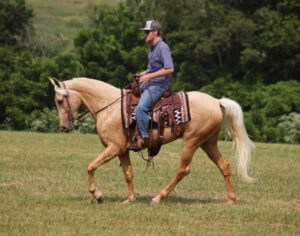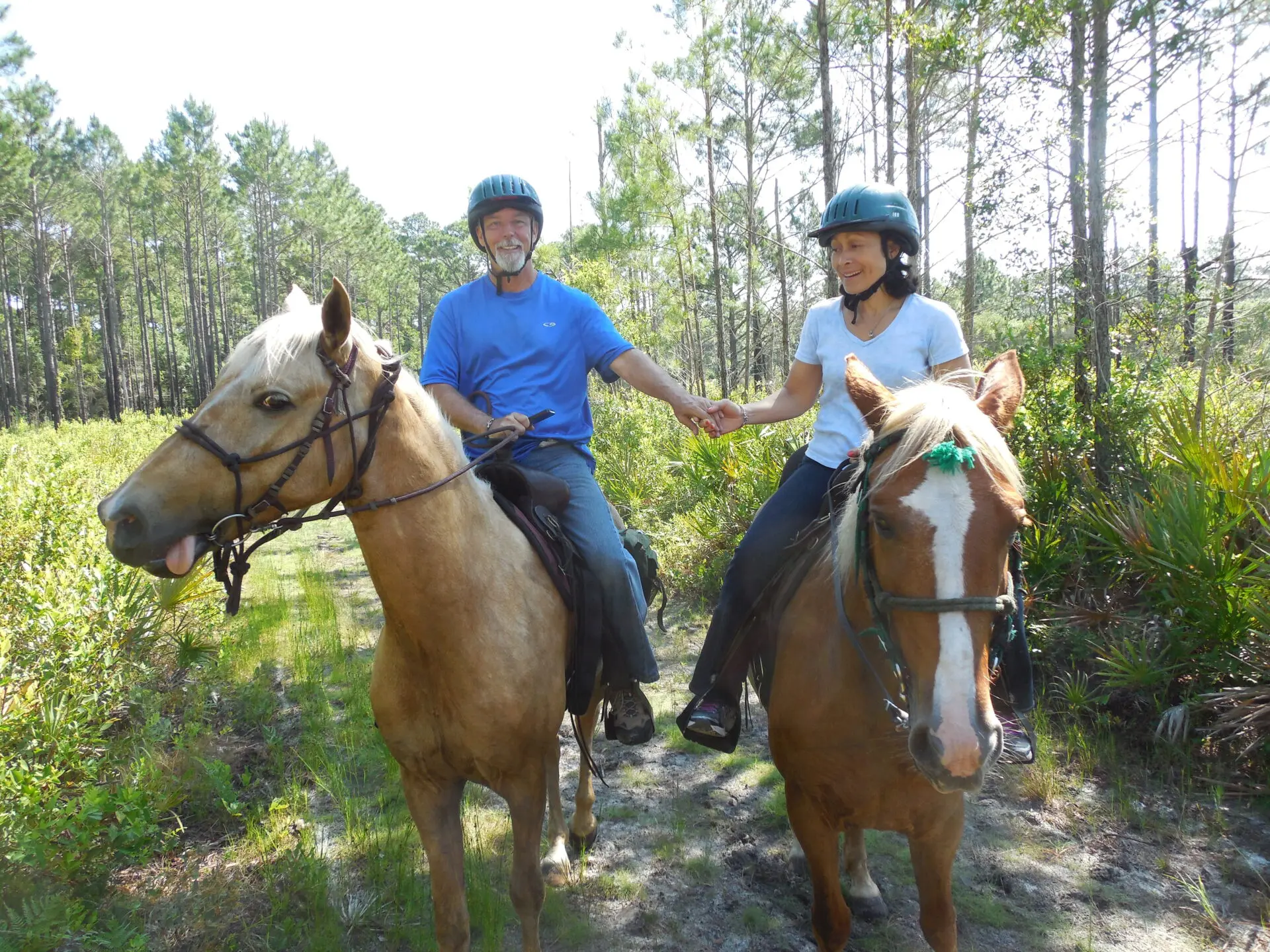
Tennessee Walking Horses are celebrated in the equestrian world for their distinctive, smooth gaits, which make them a favorite among riders seeking comfort and ease. These unique movements, including the flat walk, running walk, and canter, set the breed apart from others and offer a horseback riding experience like no other!
Understanding these gaits is essential to appreciating the Tennessee Walking Horse’s appeal, as they provide a fluid and enjoyable ride, perfect for everything from leisurely beach rides to competitive events.
The Signature Gaits of the Tennessee Walking Horse
The Flat Walk
The flat walk is a brisk, long-reaching gait that allows the Tennessee Walking Horse to cover ground efficiently at speeds of 4 to 8 miles per hour. This four-beat gait is characterized by each of the horse’s feet hitting the ground separately and at regular intervals, creating a smooth, rhythmic motion. One of the most distinctive features of the flat walk is the horse’s overstride, where the back hoof glides over the track left by the front hoof—right rear over right front, and left rear over left front. This overstride is unique to the Tennessee Walking Horse and is key to the breed’s signature smoothness.
Additionally, the horse will nod its head in rhythm with the cadence of its feet, another hallmark of the breed that judges look for in competitions. Proper execution of the flat walk involves forward motion of the hocks without excessive vertical movement, contributing to the effortless glide that defines the Tennessee Walking Horse.
The Running Walk
The running walk is the gait for which the Tennessee Walking Horse is most renowned. The running walk increases speed on the flat walk, allowing the horse to travel between 10 to 20 miles per hour while maintaining the same four-beat rhythm. Like the flat walk, the running walk features overstride but with a more pronounced reach—riders can observe the back hoof stepping ahead of the front track by six to eighteen inches. This motion gives riders the sensation of gliding smoothly through the air, akin to being propelled by a powerful yet gentle engine.

A true Tennessee Walking Horse will continue to nod its head rhythmically while performing the running walk, a characteristic that enhances the smooth, flowing experience. The running walk should never prioritize excessive speed at the expense of proper form; a well-executed running walk is as much about grace and rhythm as it is about covering ground.
The Canter
The canter of the Tennessee Walking Horse, often called the “rocking-chair” gait, is a three-beat gait performed in a relaxed and rhythmic manner. Unlike the more rigid or bouncy canters of other breeds, the Tennessee Walking Horse’s canter offers a gentle rise and fall that mimics the motion of a rocking chair. This movement is achieved through a specific sequence of footfalls: on the right lead, the horse moves in the order of left hind, right hind, and left fore together, then right fore. On the left lead, the sequence is right hind, left hind, and right fore together, then left fore. This smooth, flowing motion makes the canter a delightful and easy gait for both horse and rider, providing a sensation of effortless lifting and falling with each stride.
In the show ring, a proper canter should lead with the foreleg on the inside of the ring, adding to the elegant and balanced appearance of the gait.
Why These Gaits Are Unique
Comfort and Smoothness
One of the standout qualities of the Tennessee Walking Horse’s gaits is the exceptional comfort they provide. Unlike the trot of other breeds, which can be bumpy and tiring, the flat walk, running walk, and canter of the Tennessee Walking Horse offer a smooth, gliding motion that reduces the jarring impact on the rider’s back and joints. This makes the breed particularly suitable for riders who may have back or joint issues, as well as those who simply prefer a more comfortable ride. The gentle motion of these gaits allows riders to cover long distances without fatigue, making Tennessee Walking Horses ideal for extended trail rides and leisure riding.
Versatility in Riding
The unique gaits of the Tennessee Walking Horse also add to the breed’s versatility. These horses excel in various riding activities, from pleasure riding to competitive events. Their smooth gaits allow them to handle diverse terrains, such as rocky trails and sandy beaches, providing a comfortable experience for riders of all skill levels. Whether you’re a beginner or an experienced rider, the Tennessee Walking Horse’s ability to transition between the flat walk, running walk, and canter offers a tailored and enjoyable ride every time.
Training and Developing the Gaits
Natural vs. Enhanced Gaits
The Tennessee Walking Horse’s gaits are naturally occurring but can be improved through consistent and ethical training methods. It is important to highlight that the best training practices focus on reinforcing the horse’s natural abilities rather than artificially altering their movement. This can involve groundwork, proper conditioning, and exercises encouraging the horse to engage its muscles correctly, ensuring the gaits are performed correctly with the right form and cadence.
Ethical training is critical to preserving the integrity of the Tennessee Walking Horse’s gaits. Unfortunately, the breed has faced challenges with unethical practices like soring, which involves the use of painful chemicals or devices to exaggerate the gait. Such practices harm the horse and compromise the natural beauty of the breed’s movement. Reputable trainers use positive reinforcement techniques, allowing the horse to develop its gait naturally and comfortably, fostering a trusting relationship between horse and rider.

Tips for Riders
To fully appreciate the unique gaits of the Tennessee Walking Horse, riders should focus on maintaining a relaxed posture and staying in tune with the horse’s movements. Using light hands on the reins and gentle cues can help the horse maintain its smooth gait while sitting deep in the saddle can enhance the rider’s comfort. Taking the time to understand and appreciate these gaits will greatly enhance your riding adventure.
Experience the exceptional gaits of the Tennessee Walking Horse yourself by booking a ride at Happy Trails Walking Horses in Amelia Island, FL! Once on your horse, we perform a short riding and safety lesson then your guide leads you to a beautiful beach. Whether you’re new to horseback riding or an experienced rider, there’s no better way to explore the unique qualities of the Tennessee Walking Horse than with a memorable ride on the shores of Peter’s Point Beachfront Park.
Book your Florida horseback riding adventure now and feel the difference these unique gaits can make!

Leave a Reply